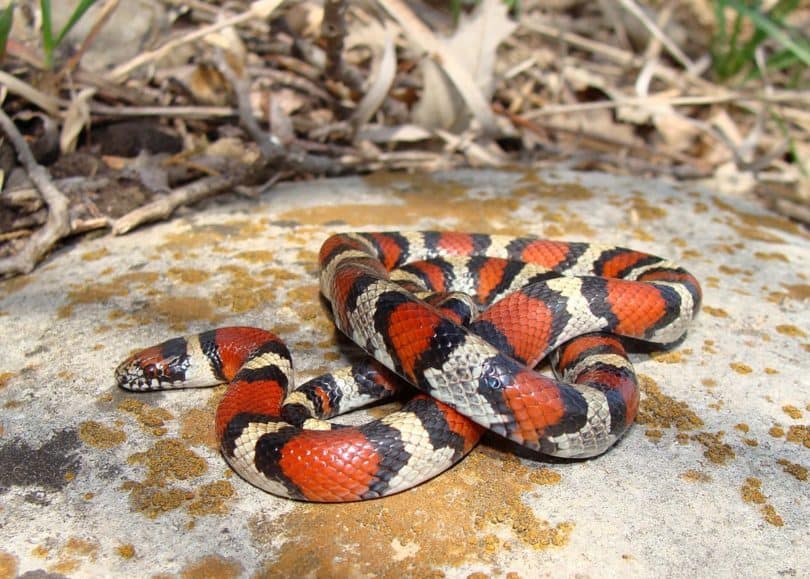If you live in Utah, you’re likely surrounded by many different species of snake. Snakes are pretty common in this state, as it is home to several different species.
Often, those in Utah are told to beware of rattlesnakes, which are one of the most common venomous snakes in the region. However, several non-lethal snakes hang out in Utah too. Some of these are easily mistaken as venomous, though they are entirely harmless.
This article will look at many of the snakes in Utah – helping you learn critical features in order to identify each one.

The 17 Snakes Found in Utah
The 4 Venomous Snakes Found in Utah
1. Great Basin Rattlesnake
| Species: | Crotalus oreganus lutosus |
| Longevity: | Unknown |
| Good to own as a pet?: | No |
| Legal to own?: | No |
| Adult size: | 15–65 inches |
| Diet: | Small mammals, birds, lizards |
There are several species of rattlesnake in Utah – the great basin rattlesnake is one of them. This species is found throughout western Utah, where it can be found in various habitats. They are usually ground-dwelling, but they can occasionally climb into trees and shrubs.
They are venomous, though they use them primarily for hunting purposes. They are light tank or yellow, with darker blotches running down their back.
2. Great Prairie Rattlesnake

| Species: | Crotalus viridis viridis |
| Longevity: | 16–20 years |
| Good to own as a pet?: | No |
| Legal to own?: | No |
| Adult size: | 35 – 45 years |
| Diet: | Small mammals, birds, lizards |
The great prairie rattlesnake is another common species in Utah. They are primarily found in southeastern Utah, where they were recently discovered.
They are primarily a ground-dwelling species. However, they will climb trees and shrubs occasionally.
They are venomous, which they use to subdue prey items. Like most venomous snakes, they have large hollow fangs in their upper jaw.
3. Hopi Rattlesnake
| Species: | Crotalus viridis viridis |
| Longevity: | 6.2 years on average |
| Good to own as a pet?: | No |
| Legal to own?: | No |
| Adult size: | 24 inches |
| Diet: | Small mammals, birds, lizards |
The Hopi rattlesnake is a smaller species of rattlesnake that is found in southern Utah. They can climb trees like all rattlesnakes, but they are mostly found on the ground.
They only grow to be about 24 inches long. They are much smaller than other rattlesnakes found in the area. They are pink or reddish, with barely-noticeable darker blotches along their back.
4. Midget Faded Rattlesnake
| Species: | Crotalus oreganus concolor |
| Longevity: | 15–20 years |
| Good to own as a pet?: | No |
| Legal to own?: | No |
| Adult size: | 24 inches |
| Diet: | Small mammals, birds, lizards |
This is another species of rattlesnake – this time mainly found in eastern Utah. They are usually found on the ground, but they can climb onto trees and shrubs as well. They are known to congregate in large numbers, especially during the colder months.
They are venomous and look similar to other rattlesnakes. The darker splotches on their back are usually very recognizable, as is their rattle.

The 2 Water Snakes Found in Utah
5. Black-Necked Garter Snake

| Species: | Thamnophis Cyrtopsis |
| Longevity: | 2 years |
| Good to own as a pet?: | Yes |
| Legal to own?: | Yes |
| Adult size: | 16 – 28 inches |
| Diet: | Amphibians |
There are several types of garter snakes found in Utah, with the black-necked garter snake as one of them. However, this is one of the rarer subspecies.
It is distinguishable because it has two large black blotches on the back of its head.
They are typically found near water, where their primary food source lives. They are most active from April to October.
6. Ring-Necked Snake
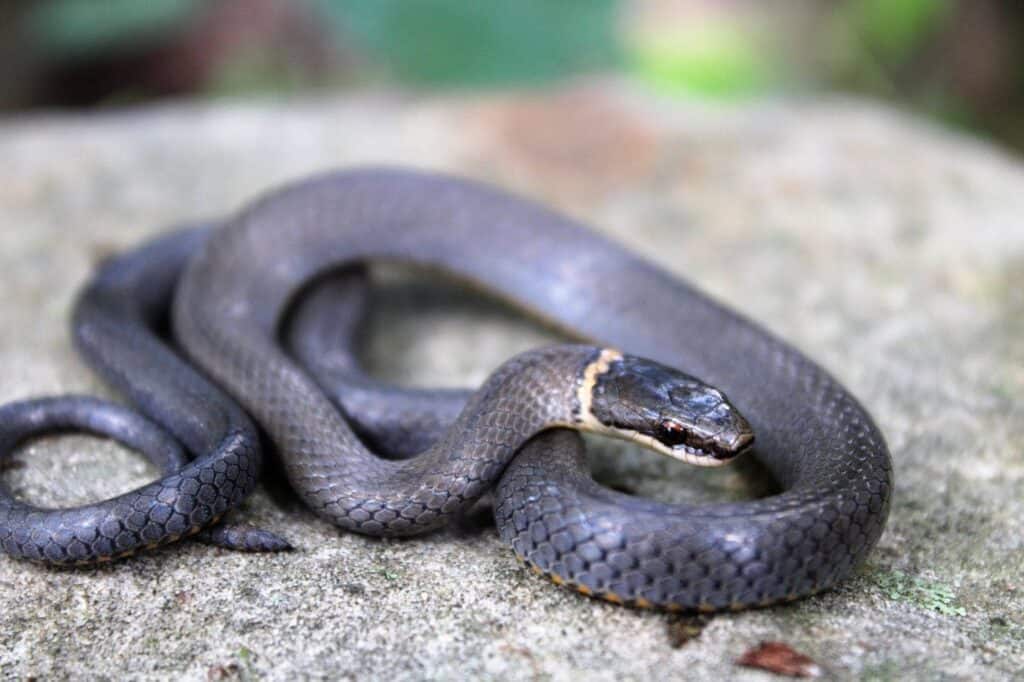
| Species: | Diadophis punctatus |
| Longevity: | 8–10 years |
| Good to own as a pet?: | No |
| Legal to own?: | Yes |
| Adult size: | 10–15 inches |
| Diet: | Amphibians, lizards, snakes |
This species is native to Utah, mostly in the central areas of the state. They are not particularly abundant, but it isn’t odd to come across them.
They are grey or darker in color, with an extremely bright orange/yellow belly. Many do have a similarly colored neckband – hence their name. However, not all of them do. It is missing from some individuals.
They can be found in a variety of habitats, but they do prefer to be around water. They are secretive and nocturnal, so many people don’t just stumble upon them.

The 11 Other Snakes Found in Utah
7. Coachwhip
| Species: | Masticophis flagellum |
| Longevity: | 16+ years |
| Good to own as a pet?: | Yes |
| Legal to own?: | Yes |
| Adult size: | 50–72 inches |
| Diet: | Lizards, snakes, birds, eggs |
The coachwhip is limited to the southwestern corner of the state. They are well-known for tolerating scorching weather, which allows them to remain active throughout much of the day. They prefer dry, open terrain.
Often, you can find them in grassland, desert, and agricultural areas.
They are most active in the spring and summer. In the winter, they take refuge in old rodent burrows.
8. Common Garter Snake
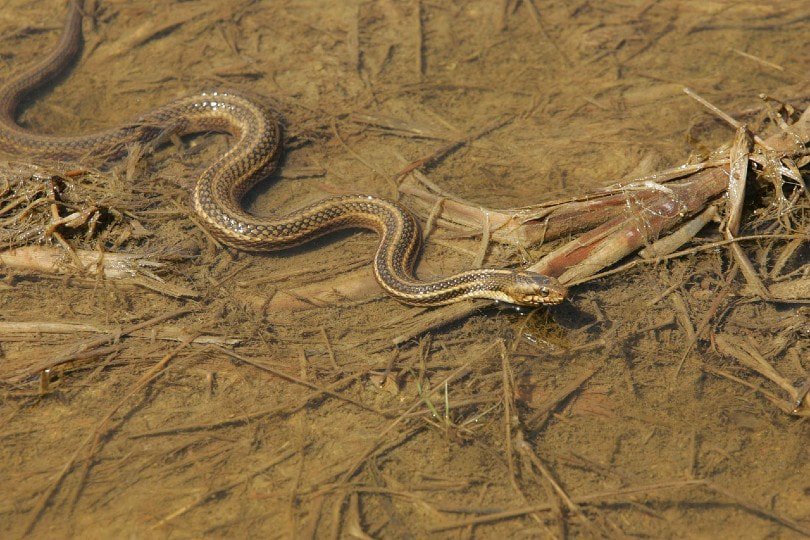
| Species: | Thamnophis sirtalis |
| Longevity: | 4–5 years |
| Good to own as a pet?: | Yes |
| Legal to own?: | Yes |
| Adult size: | 18–26 inches |
| Diet: | Earthworms, fish, insects |
Garter snakes are extremely common. They occur throughout many of the arid regions in the United States. They are found throughout most of Utah.
This species is entirely harmless. Most of their diet includes earthworms and similar insects. They do eat small birds occasionally.
You can find them in most moist habitats, where they are active at night and during the day. They remain underground during the colder parts of the year and remain inactive.
9. Common Kingsnake
| Species: | Lampropeltis getula |
| Longevity: | 20–30 years |
| Good to own as a pet?: | Yes |
| Legal to own?: | Yes |
| Adult size: | 2–6 feet |
| Diet: | Reptiles and small mammals |
The kingsnake is only common to the southern part of the state. It lives in a variety of habitats, including agricultural areas, woodland, and deserts. Like most snakes, they are only active during the hotter parts of the year.
They prey on reptiles, birds, and small mammals. They may occasionally eat eggs. They also occasionally eat rattlesnakes – one of the few animals to do so.
10. Corn Snake

| Species: | Elaphe guttata |
| Longevity: | 6–8 years |
| Good to own as a pet?: | Yes |
| Legal to own?: | Yes |
| Adult size: | 2–6 feet |
| Diet: | Rodents, bats, birds, insects, other snakes |
Corn snakes are found mostly in eastern Utah. They typically live in streams, rocky areas, and forests. They are mostly active at night, especially in the hotter summer months.
They commonly eat bats, birds, insects, lizards, and other snakes.
They vary somewhat in color, ranging from light grey to darker grey. They usually have dark blotches on their back, with two markings on the back of their neck in a V-shape.
11. Eastern Racer
| Species: | Coluber constrictor |
| Longevity: | Up to 10 years |
| Good to own as a pet?: | Yes |
| Legal to own?: | Yes |
| Adult size: | 24–48 inches |
| Diet: | Large insects, reptiles, birds, and small mammals |
The eastern racer is a larger snake that is common throughout much of North America. They are inactive during the cold winter months when they hibernate. They are one of the few snakes to hibernate communally.
They are typically found in open fields and meadows. They may also be located in woodlands, though they prefer more open spaces. They can climb trees, but they are mostly ground-dwelling.
12. Gopher Snake
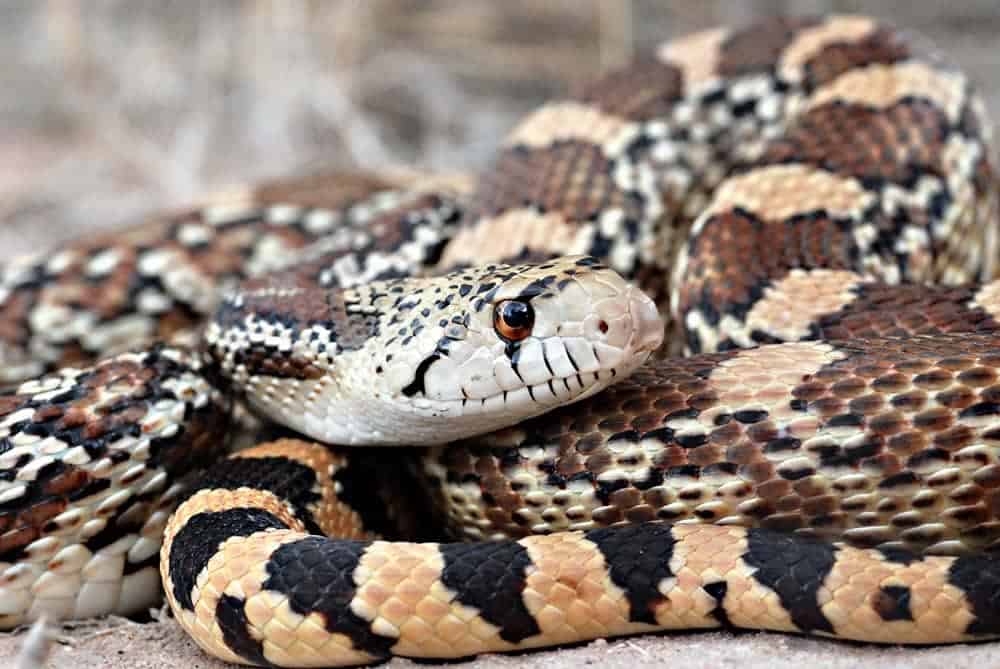
| Species: | Pituophis catenifer |
| Longevity: | 12–15 years |
| Good to own as a pet?: | Yes |
| Legal to own?: | Yes |
| Adult size: | 48–66 inches |
| Diet: | Birds, small mammals, lizards, insects |
The gopher snake can be found in a variety of different locations, ranging from dry fields to mountains. They are great climbers and burrowers, allowing them to adapt to a number of locations.
These snakes have a similar adaptation to rattlesnakes. They will vibrate their tails when alarmed. However, they are not venomous. They often kill their prey by constriction instead.
They are large, with some individuals exceeding 100 inches.
13. Ground Snake
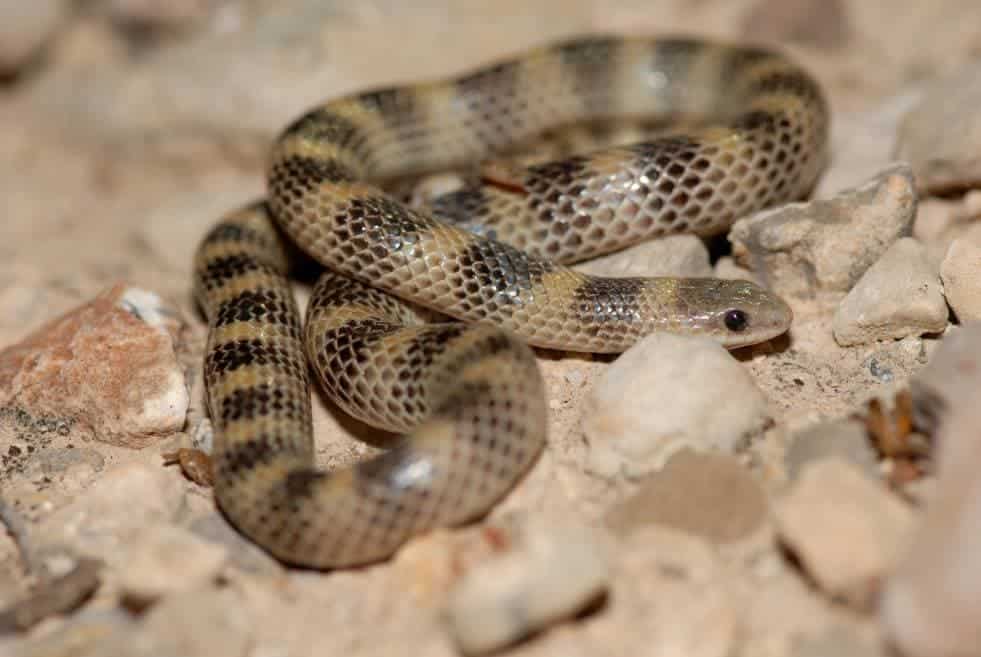
| Species: | Sonora semiannulata |
| Longevity: | 15–20 years |
| Good to own as a pet?: | Yes |
| Legal to own?: | Yes |
| Adult size: | 8 inches |
| Diet: | Insects |
The ground snake is located throughout much of the southwestern United States, including Utah. They are only found in the southwestern corner, though.
They are a shy species that tends to keep to themselves. They hid in rocky hillsides and sandy areas.
Their main source of food is insects and spiders, though they will eat any invertebrate.
They’re easy to identify due to their bright red and black stripes. They look quite unique compared to other snakes in the area.
14. Long-Nosed Snake
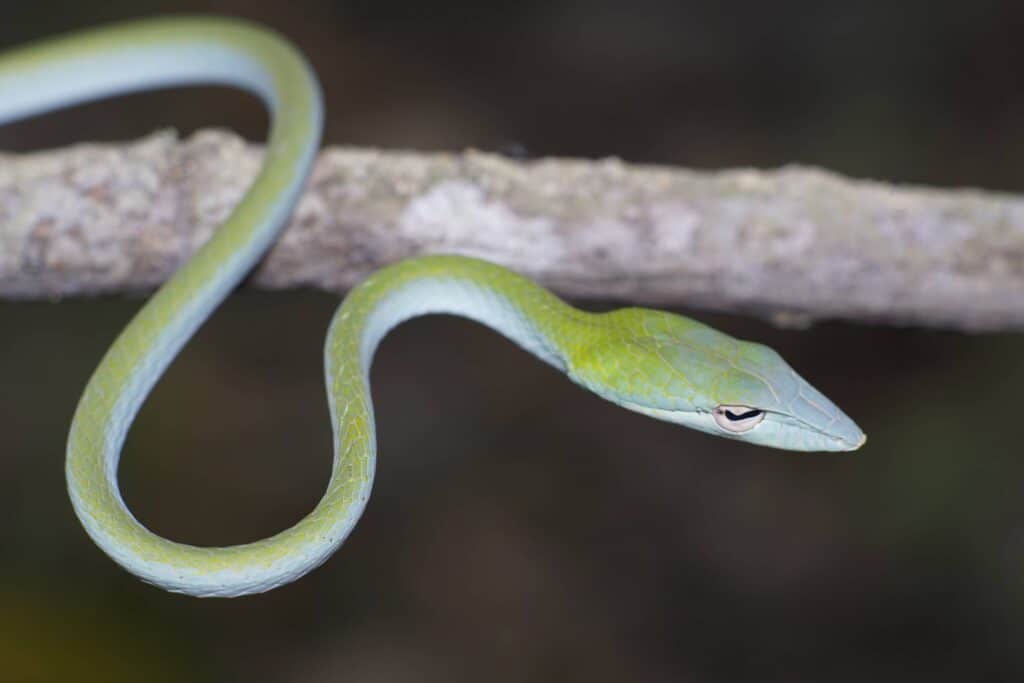
| Species: | Rhinocheilus lecontei |
| Longevity: | 12–20 years |
| Good to own as a pet?: | Yes |
| Legal to own?: | Yes |
| Adult size: | 3 feet |
| Diet: | Lizards, lizard eggs |
This medium-sized snake is mostly found in the western part of Utah. They are nocturnal and only active in the warmer months.
Their main prey includes lizards and their eggs. But they will also eat other snakes and rodents as they become available. They’re quite opportunistic when it comes to their eating patterns.
They have black and red stripes along their back, which makes them look somewhat like the western coral snake. However, they are completely harmless. (The western coral snake also does not occur in Utah; sightings are usually of long-nosed snakes.)
15. Milk Snake
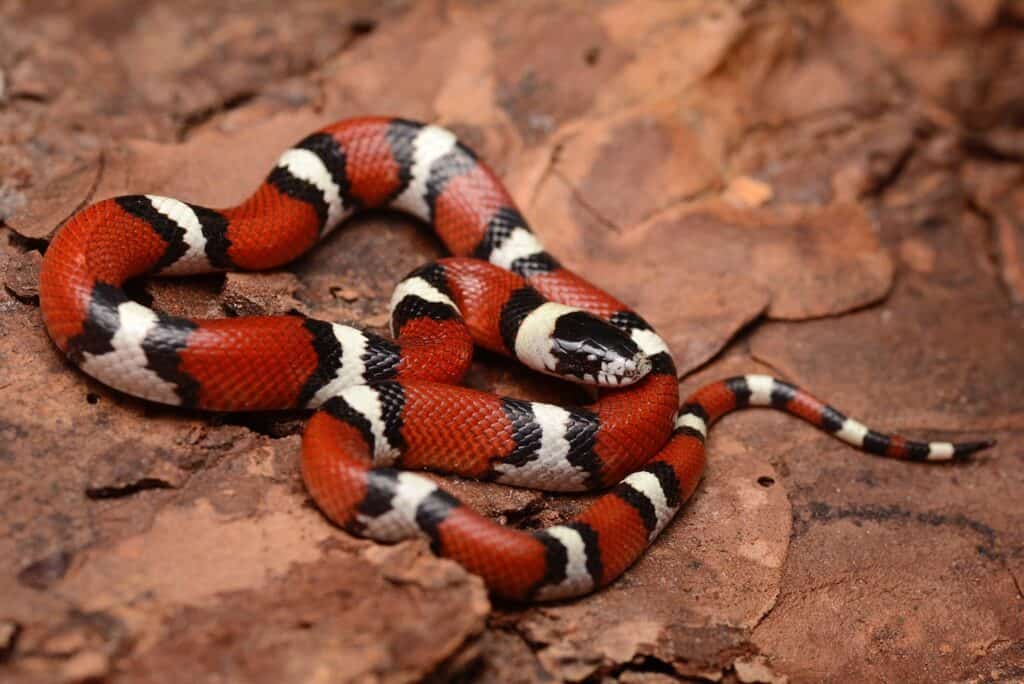
| Species: | Lampropeltis triangulum |
| Longevity: | Up to 15 years |
| Good to own as a pet?: | Yes |
| Legal to own?: | Yes |
| Adult size: | 24 – 26 inches |
| Diet: | Small mammals, small birds, reptiles, eggs |
In Utah, this species can be found in the middle and eastern portions. They eat all the things you’d expect a snake to, including mammals, birds, reptiles, and a variety of eggs.
They have red and white stripes, with small, darker stripes in between. This looks somewhat like the coral snake, which is venomous. However, this species is completely harmless. Their coloration likely evolved as a mimicry to scare off predators.
This species can be found in many different habitats and is largely active at night. They also hibernate during the colder months.
16. Night Snake

| Species: | Hypsiglena torquata |
| Longevity: | 12 years |
| Good to own as a pet?: | No |
| Legal to own?: | No |
| Adult size: | 12–26 inches |
| Diet: | Lizards and lizard eggs |
Night snakes are rather common in the desert regions of Utah. They inhabit arid desert flats, as well as plains and some woodlands. They prefer rocky and sandy soils.
Their main diet consists of lizards and their eggs. However, they may also eat frogs, insects, and other snakes. They do have venom that they use to subdue their prey.
However, they are not venomous to people. They deliver very small amounts of venom and rarely bite people – even when handled. Still, they are commonly not kept as pets for this reason.
17. Rubber Boa
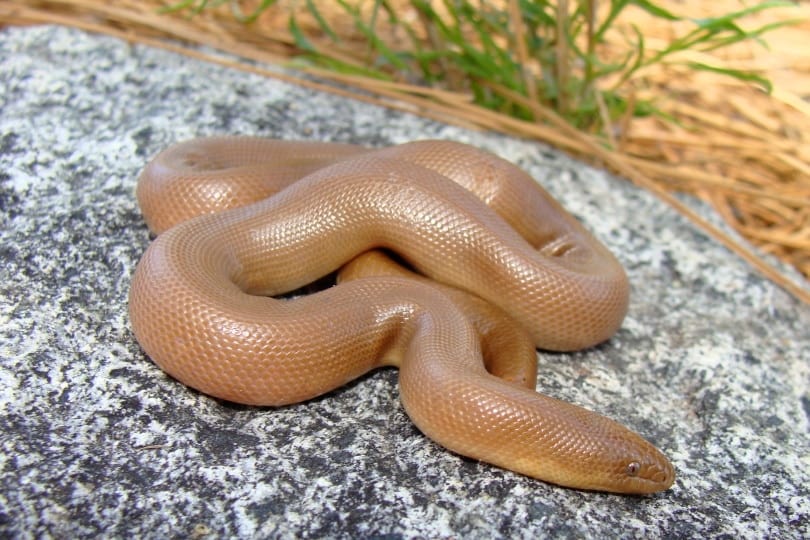
| Species: | Charina bottae |
| Longevity: | 40–50 years |
| Good to own as a pet?: | No |
| Legal to own?: | Yes |
| Adult size: | 21–26 years |
| Diet: | Shrews, mice, lizards, and small birds |
In Utah, this species is found in the northern portion of the state. They are mostly in the Wasatch Mountains.
As the name suggests, they mostly kill their prey through constriction. They eat small mammals like shrews and mice. They may also eat other smaller snakes and small birds.
They are nocturnal and only active from March to November in most cases.

Conclusion
There are many species of snakes in Utah. Most of them are harmless. In fact, the various rattlesnake species are the only seriously venomous snakes. There are a few that produce venom, but not in any large amounts.
Identifying rattlesnakes is quite easy. They look different from other snakes in the region.
It is important to point out that the western coral snake is not native to Utah. There are other snakes that look like this venomous one. However, all the similar snakes in Utah are not venomous.
You may also want to read about:
Featured Image Credit: Matt Jeppson, Shutterstock
